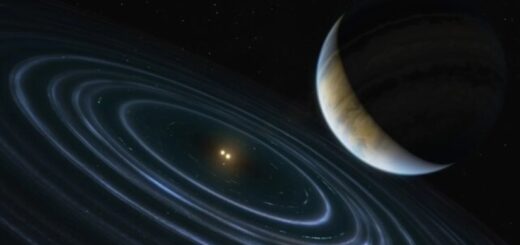South Atlantic Anomaly – Could Black Holes On Earth Be Portals To Parallel Universes?
Black holes are strange objects we encounter in space. They are not only mysterious and very fascinating to astronomers, but also incredibly powerful forces.
A black hole is a place in space where gravity pulls so much that even light can not get out.
The gravity is so strong because matter has been squeezed into a tiny space. This can happen when a star is dying.
Because no light can get out, people can’t see black holes. They are invisible. The reason why we why we can know black holes’ existence is because space telescopes with special tools can help find black holes. The special tools can see how stars that are very close to black holes act differently than other stars.

So what is the connection between the South Atlantic Anomaly and black holes?
The South Atlantic Anomaly (SAA) refers to the area where the Earth’s inner Van Allen radiation belt comes closest to the Earth’s surface. This leads to an increased flux of energetic particles in this region and exposes orbiting satellites to higher than usual levels of radiation. The effect is caused by the non-concentricity of the Earth and its magnetic dipole, and the SAA is the near-Earth region where the Earth’s magnetic field is weakest.
The shape of the SAA changes over time.
The South Atlantic Anomaly is of great significance to astronomical satellites and other spacecraft that orbit the Earth at several hundred kilometers altitude; these orbits take satellites through the anomaly periodically, exposing them to several minutes of strong radiation, caused by the trapped protons in the inner Van Allen belt, each time.
As described in Technology Review’s article” the vortices that can form in turbulent water are a familiar sight. Edgar Allan Poe described just such a whirlpool in his short story “A Descent into a Maelstrom” which he published in 1841:
“The edge of the whirl was represented by a broad belt of gleaming spray; but no particle of this slipped into the mouth of the terrific funnel… ”
In this passage, Poe describes one of the crucial feature of these rotating bodies of fluid: that they can be thought of as coherent islands in an incoherent flow.As such, they are essentially independent of their environment, surrounded by a seemingly impenetrable boundary and with little, if any, of the fluid inside them leaking out.
If you’re thinking that this description has a passing resemblance to a black hole, you’d be right.
Haller and Beron-Vera put this similarity on a formal footing by describing the behaviour of vortices in turbulent fluids using the same mathematics that describe black holes.
In this picture, Poe’s “broad belt of gleaming spray” is exactly analogous to a photon sphere around a black hole.
This is a surface of light which encircles a black hole without entering it.
Haller and Beron-Vera go on to show that each vortex boundary in a turbulent fluid contains a singularity, just like an astrophysical black hole.
That has important implications for the study of fluids and the identification of vortices, which are otherwise tricky to define and spot.
In this case, it is simply question of looking for the singularity and the boundary that surrounds it.
And that’s exactly what Haller and Beron-Vera have done in the pattern of currents in the south west Indian Ocean and the South Atlantic. A well-known phenomenon in this part of the world is called the Agulhas leakage which comes from the Agulhas current in the Indian Ocean.
“At the end of its southward flow, this boundary current turns back on itself, creating a loop that occasionally pinches off and releases eddies (Agulhas rings) into the South Atlantic,” they say.
These guys used satellite images of the South Atlantic Ocean from between November 2006 and February 2007 to look for vortices using a set of simple computational steps that spots black hole analogues.
In this three-month period they found eight candidates, two of which turned out to be black hole analogues containing photon spheres. “We have found exceptionally coherent material belts in the South Atlantic, filled with analogs of photon spheres around black holes,” they conclude.
That’s an interesting result that could have significant implications for our understanding of the way ocean currents transport material. Since anything that gets into these black holes cannot get out, this should trap any garbage, oil or indeed water itself, moving it coherently over vast distances. “Beyond the mathematical equivalence, there are also observational reasons for viewing coherent…eddies as black holes,” say Haller and Beron-Vera.
The work also raises the possibility that black hole analogues will occur in other situations, such as in hurricanes and not just on Earth. By this way of thinking, the Great Red Spot on Jupiter might well be the most famous black hole in the Solar System.”
An intriguing possibility is that such remarkable vortices could be gateways to parallel worlds or other dimensions…



 Creators of mankind
Creators of mankind Description of “Tall white aliens”
Description of “Tall white aliens” Where they came from?
Where they came from? About hostile civilizations
About hostile civilizations The war for the Earth
The war for the Earth “Tall white aliens” about eternal life
“Tall white aliens” about eternal life Video: “Nordic aliens”
Video: “Nordic aliens” Aliens
Aliens Alien encounters
Alien encounters The aliens base
The aliens base UFO
UFO Technology UFO
Technology UFO Underground civilization
Underground civilization Ancient alien artifacts
Ancient alien artifacts Military and UFO
Military and UFO Mysteries and hypotheses
Mysteries and hypotheses Scientific facts
Scientific facts


















